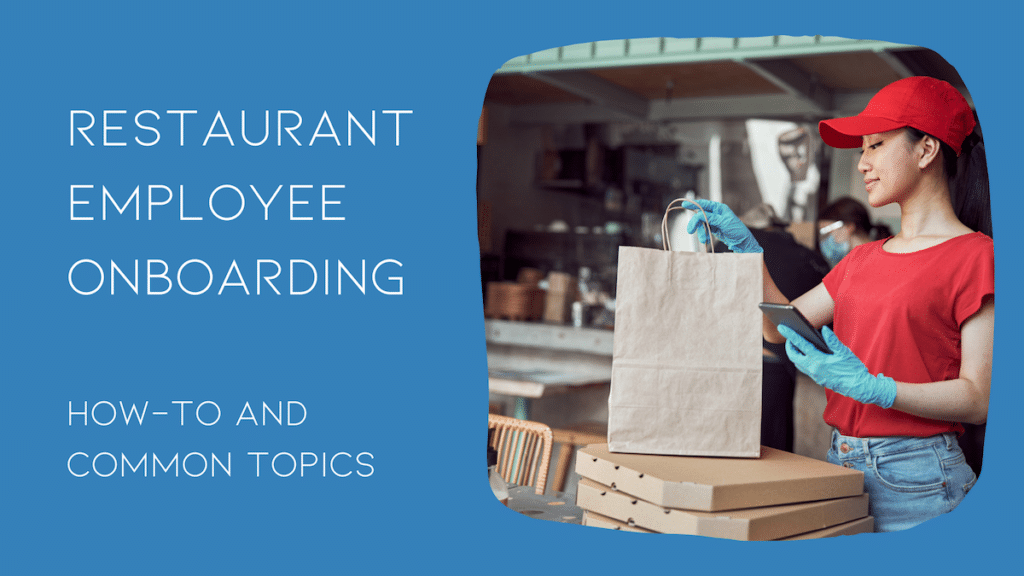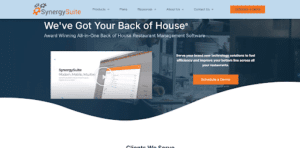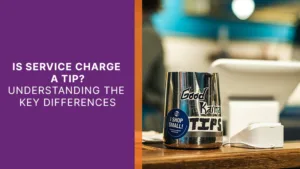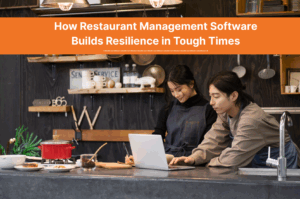Restaurant Employee Onboarding Flow for New Restaurant Employees
Updated on: May 24, 2023
Whenever a new employee starts working at your business, there is a lot of training material to cover. One of the best ways to help your new employee to love their new job is to make sure that the onboarding process and initial training is well thought-out and smooth. Your restaurant employee onboarding process should be customized to fit your brand and workflow, but here are the general steps that are common for all restaurant onboarding processes.
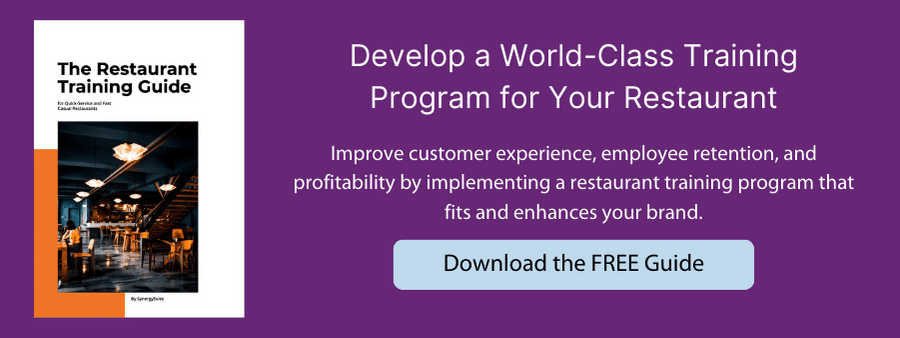
Administration and Required Paperwork
Before jumping into the nitty-gritty of a new job, it’s best to make sure that things are made official by completing all the necessary paperwork and administrative items for new employment. The requirements for this may vary depending on the location of the restaurant, or internal corporate policies, but usually the paperwork remains pretty standard across the board. For instance, for U.S.-based companies, there will be these foundational forms:
- Complete the I-9 Form for Employment Eligibility
- Complete the W-4 Form for Income Taxes
- Complete any state-specific forms
If you’re located outside of the U.S., you will likely need to fill out equivalent forms as regulated by your national or provincial governments.
For most quick-service and fast casual restaurant chains, a representative from the HR department should be present to explain the forms, answer any questions, and ensure that all the required items are taken care of. If there is not an HR representative available, then whoever is tasked with managing this portion should definitely be available on the first day an employee begins employment.
Orientation and Education
Once all the necessary paperwork is completed, it’s time to get the new employee oriented in their new workplace. This doesn’t just include the restaurant itself, but the team, the tools, and of course, the food they’ll be working with. This is also an important step to communicate what your brand is all about and to introduce the culture you are trying to cultivate in your restaurant business.
Basically you want your new employee to feel like they know who they’re working for, and what their new environment will be. Here are the areas that should be focused on when getting your new employee oriented to their new position.
Training Materials and Expectations
Getting the new employee familiar with their training materials will help them feel more comfortable in the choice they made to work in your restaurant business. A clear outline of what will be covered will help them feel more situated, and prepared for what is to come. Here are some of the things you should cover in this step:
- A general overview and summary of the restaurant training manual.
- An outline of how the training process will go, so they know what to expect and can feel mentally and emotionally prepared for what is to come.
- Particular explanation of what their job role will be, where they fit in the organization, and what expectations there are for them to do their job well.
- Don’t forget to also explain what could be on the horizon for them. One of the best things you can do to motivate your new employee is to explain what the potential for them is, and what path there may be for them for an even better situation. This could be in terms of pay increases, promotions, or other incentives.
Familiarity with the Workplace Itself
When thinking about new restaurant employee onboarding, the first thought is usually about new front-line team members working with customers. But this step is important for employees of all types, from the cash register, to the kitchen, to the manager’s office, and even in corporate headquarters.
The workplace is where your new employee will be spending a huge chunk of their time, so getting them familiar with their new space should be one of the first steps to helping them feel welcomed and secure in their new position.
While the location may vary depending on the job role itself, it’s probably a good idea to get the new employee familiar with the establishment as a whole. Even a new operations assistant in the corporate office will benefit from becoming familiar with the layout of your restaurants, and what the day-to-day life is like for the majority of company employees.
Here are a few items to cover that may help with becoming familiar with the workplace, regardless of the position of the new employee:
- Restaurant layout: this is more important for those working within the restaurant itself, but it’s also helpful for kitchen staff, and those who work in the corporate office. This helps new wait staff members navigate the floor efficiently and avoid accidents. It also helps those who don’t work in the restaurant itself on a day-to-day basis understand the conditions and the environment of those they work with.
- The Menu: one of the best parts of working for a restaurant company is the opportunity to eat delicious food! Every one of your employees should know what menu items they absolutely love, and they can’t make that decision until they’ve tried it out themselves.
- Overview of tools and supply locations: regardless of what role your new employee is there to fill, they will always need to know what tools they have to work with, and where they can get supplies for their tasks. While this is particularly important and more complex on the restaurant floor and in the kitchen, working with food and other perishable items, it’s also important for your office staff as well.

Familiarity with Your Brand and Organization
By the time you’ve gotten to this point, the new employee already has a little experience with your brand. The first people they have met will (hopefully) have been a good representation of how they can expect to be treated, and how they should treat others, at your organization.
Beyond that, it’s important that they have at least a basic understanding of how your company is structured, who they will report to, and what values and culture they will be expected to fit into and uphold.
Here are some things that may be helpful for you to walk through with them:
- Organizational structure: A thorough review of all the staff, departments, and roles within the organization, and particularly at the location they’ll be working at, will give them a better idea of where they’ll fit in, and who they may be communicating with on a frequent, or even less-than-frequent basis.
- Chain of command: Once they have an understanding of the organization, walk them through who they will be reporting to, who they report to, and who to go to for help or questions if those lines of communication are not available.
- HR contact: Let your new employee know who to contact in the HR department in case any emergency, complaint, or general HR question arises.
- Restaurant culture: Whether your new employee is engaging with customers every day, or just working behind the scenes, they will always be a representative of your restaurant business. Giving them a clear understanding of the culture you are trying to create there will not only help them to succeed in helping to build it, but will also help them to feel more comfortable and comfortable in their decision to work there.
Restaurant Technology Overview
Restaurants today, particularly in quick-service and fast casual restaurant chains, gain tremendous advantages and efficiency by using restaurant technology. Every employee, regardless of position, uses some sort of restaurant technology in order to do their job well.
While some job roles may use different technology than others, you’ll want to walk your new employee through what will be vital for them to become familiar with to do their job on a day-to-day basis. Here are some of the common technologies that will likely be required to review during restaurant employee onboarding:
- Timekeeping Tools: Almost every employee working within the restaurant will be required to clock in and out to track their work hours. While old-school punch cards may still be around in some places, nearly everyone is now using timekeeping software or mobile apps to streamline this process.
- Scheduling Tools: Managing the shift schedule is one of the biggest challenges of managing an efficient restaurant. Many restaurant chains have implemented some sort of restaurant scheduling software to help with this process. But even if you’re still using spreadsheets or word documents to manage your schedules, you’ll definitely want to walk your new employees through the process.
- HR and Training Technology: Many restaurant chains have now implemented, or should consider implementing HR software for managing payroll, employee files and documents, and even training. If you don’t have a software solution, it’s still important to walk the employee through these processes, however you have them organized.
- Point-of-Sale System: If your new employee is working within the restaurant itself, it’s almost certain they will have to interact with your point-of-sale solution at some point. Help your new employees understand what system you’re using, and who to talk to for help managing it. The details of training the employee on the point-of-sale system will likely be part of their own job-specific training.
There are other common technologies used in restaurants, such as inventory management software, restaurant operations software, and reporting & analytics tools, but those are more job-specific and will most likely be a part of the individual training for each job role.
Demonstration
After thoroughly digesting the training manual, the next steps of restaurant employee onboarding are first-hand demonstrations, shadowing, and hands-on learning. In quick-service and fast casual restaurants, new team members are generally expected to wear quite a few different hats, depending on their roles and what shifts they are assigned to. Details for specific roles will be explained a little later, but here we’ll note that the demonstration is of vital importance to the restaurant training process.
Finding time and a place for one-on-one demonstrations can sometimes be tricky, but it’s important to be able to provide an example of how tasks should be accomplished without the distractions and bustle surrounding normal shift hours.
- You should have designated employees with ample experience to provide 1-on-1 demonstrations of special focus areas (cooking, customer interaction, anything that’s considered “your brand’s way”).
- Cross-training with more than one employee can help make your training process more efficient, provide additional perspective, and foster team building.
- Never underestimate the power of example. Every new employee will look to those that have experience, not just for how to do the job, but also the feeling and attitude toward the job that will likely be their experience.
Shadowing
To support one-on-one demonstrations, which generally take place outside of the busy workflow of a normal shift, shadowing will put demonstrations into context for a new employee. A demonstration can be an isolated step of the process of a shift, but shadowing will provide a framework for what comes before, what to watch for during, and then what the next steps are for each task a new employee will be asked to perform.
- Shadowing experienced employees during actual shifts provides the building blocks for their first days of solo work
- After hitting a point of understanding and confidence, flip the roles and allow a veteran employee to shadow the new hire

Test Shift
Once you and the new employee are feeling pretty comfortable with each required task, and the general workflow of the restaurant, it’s time to let them try swimming on their own.
Ideally, schedule a shift for the employee that is not typically the peak of when your restaurant is busiest, so they can get a feel for the general workflow before becoming overwhelmed. If the shift also covers a busier time, and a time with more down-time, then you can have an opportunity to have the employee complete their work, and then a time to provide feedback, complete additional training, and help them generally feel more comfortable with how things will generally go on a day-to-day basis.
Feedback and Improvement
Feedback is of course an essential part of all training, whether that’s during the onboarding of a new employee or for ongoing training throughout their employment. During the onboarding phase, you’ll have the opportunity to provide an example to the new employee of how feedback typically will be delivered by their managers, how performance reviews will be managed, and how they can also provide feedback about your restaurant training program.
Before an employment has completely finished their restaurant employee onboarding process, you’ll want to make sure you have a formal one-on-one with them to have an open communication about what you’re seeing they do well, what they can improve, and to allow them the opportunity to provide feedback on the onboarding process. While the feedback you give is important for the employee, make sure you also listen to their feedback, as they may present some ideas or corrections that will benefit many other employees in the future.
Training Topics for All New Employees, Regardless of Job Role
While each role within your food service business has very different day-to-day tasks, there are things that everyone should be trained on, regardless of their role.
Customer Service and Sales
Customer service and sales protocol goes beyond just what the wait staff accomplishes during a customer visit. Nearly everyone at some point or another will have interactions with customers, so it should be made clear what your brand’s expectations are in terms of the attitude and conduct toward customers. New employees must be trained on how to handle difficult customers, how to upsell menu items, and how to handle customer complaints. It is important for staff to understand the importance of providing excellent customer service and the impact that it has on the restaurant’s overall success.
Compliance and Safety
All restaurants have regulatory compliance they must follow. This generally includes federal and state codes regarding cleanliness and safe preparation of food. Employees should be able to reference any safety information in this section, including emergency protocols and first aid questions. Some important topics that should be included can be:
- Food safety: New hires should be trained in proper food handling and sanitation procedures to ensure that food is safe to eat. This includes information on food storage, food preparation, and cleaning and sanitizing procedures. They should also be trained on food allergies, cross-contamination, and how to handle food-borne illnesses.
- Occupational Safety and Health Administration (OSHA): In the United States, all employees should be trained on OSHA regulations and guidelines, including safe work practices, emergency procedures, and hazardous materials handling. Outside of the U.S., it’s likely that your country’s regulatory bodies also require similar training. Each country, state, or province will have its own requirements and regulations, so make sure to check with your local government agencies for the most up-to-date information.
- Workplace Safety: New hires should be trained on how to handle equipment and tools safely, how to prevent slips, trips, and falls, how to use fire extinguisher and other safety equipment, and how to respond to emergency situations.
- Alcoholic Beverage Control (ABC) laws: This may not pertain to all quick service restaurants but it should be a key training element if so. New employees should be trained on the laws and regulations related to the service of alcohol, including legal drinking age and how to identify and handle over-intoxicated customers.
- Sexual Harassment and Discrimination Prevention: All employees should be trained on the restaurant’s policies and procedures related to preventing sexual harassment and discrimination in the workplace and how to report any incidents.
- Data Protection: All employees should be trained on the restaurant’s policies and procedures related to the protection of customer data and their personal data, such as Payment Card Industry Data Security Standard (PCI-DSS) compliance and the General Data Protection Regulation (GDPR) compliance.
- Employee Hygiene: All employees should be trained on employee health and wellness policies such as hand washing, cough and sneezing etiquette, and how to stay healthy while working in the restaurant.
Operations
This section is reserved for general operations and chain of command information. General day-to-day expectations, including opening, closing, and hours of operation, are included here. While there may not be a tremendous amount of daily overlap between different areas of your business, or between locations, it can be helpful for employees throughout your organization to know how everything is structured. Some helpful topics to include in this type of training include:
- Restaurant policies and procedures: Employees should be familiarized with the restaurant’s policies and procedures, including dress code, punctuality, break policies, and other important rules. They should also be trained on the standard operating procedures (SOPs) of the restaurant, which are the step by step instructions for each task in the restaurant.
- Chain of command: All employees should be familiarized with the restaurant’s organizational structure, including who their direct supervisor is, who to report to in case of an emergency, and who to go to for help or assistance.
- Job duties and responsibilities: It is important employees know their roles and what is expected of them. They should be trained on their specific job duties and responsibilities, including how to properly use equipment, how to handle cash and credit card transactions, and how to maintain a clean and safe work environment.
- Scheduling: New employees should be trained on the restaurant’s scheduling policies and procedures, including how to request time off and how to find their schedule.
Increase Restaurant Employee Onboarding Efficiency with Restaurant HR Software
In today’s culture, and when working within a restaurant enterprise with many locations, you can save yourself a lot of time and effort during restaurant employee onboarding by utilizing restaurant HR software. This software can be incredibly useful for keeping updated versions of your manuals, videos, and other resources in a place that can be accessed and referenced from anywhere and at any time.
Not only that, but restaurant HR software can also help you create onboarding and training documents and checklists that will ensure that each employee is up-to-date on their training, and that no important topics are missed. This can be especially useful when you are managing the training of new employees across a large number of locations, saving your HR department a lot of time and energy in tracking the progress of each new employee.
Additional Topics for Your Restaurant Training Program
Your restaurant training program will likely cover a wide range of topics, and can be implemented in just as many ways. Check out more of our training program resources to make the most of your restaurant training program:
- Creating a Restaurant Training Manual
- Methods for Training Employees in Restaurants: Pros, Cons, and Tools
- Role-Specific Restaurant Training in Quick-Service and Fast Casual Restaurants
- Continuing Restaurant Training After Onboarding
- Additional Training Topics for Restaurant Employees

